TUBER SHAPES AND SIZES
Tubers purchased at dahlia club sales are often exotic varieties not readily available from commercial vendors. While the tubers these varieties produce may not be the textbook-perfect examples sold by commercial growers, these randomly sized tubers will grow just fine.
PLANNING THE GARDEN
Dahlias, with their limitless shapes and colors, add beauty to any garden venture. Get off to a good start by planting the best varieties. Then follow this guide for a festival of blooms from July until the first frost.
LOCATION
The ideal location for dahlias is one in full sun. However, the plants will tolerate some shade. Avoid planting close to trees.
DRAINAGE
The soil must be well drained. While dahlias love water, they cannot prosper in waterlogged conditions. In sandy soils, water drains away too quickly and may cause mature plants to collapse. If your soil conditions are poor, try using raised beds. Compost always helps.
PLANTING
Dahlias can vary in height from one to seven feet. Check each variety for its expected height and plant where suitable — the taller ones to the rear of the garden and the low-growing dahlias in front or between other plants. Dwarf varieties are perfect for borders or containers. Space dahlias according to bloom size: the larger-flowering varieties should be planted 2-3 feet from others; the smaller varieties can be planted 18 inches apart.
SOIL
Dahlias thrive in well-prepared, friable soil. A neutral soil is preferable to a highly acid one. Rich loam is their favorite. The addition of organic material (compost, leaf mold, or aged manure) will help all types of soil. Commercial compost is an excellent soil amendment, especially where sandy soil prevails.
FERTILIZERS
About two weeks before planting, broadcast 5-10-10 granular fertilizer over the soil and spade it in. When the dahlia plants are 6 inches high, apply a water-soluble amendment high in nitrogen, such as fish fertilizer. Later in the season — just when flowers begin to bloom — apply a liquid fertilizer that is low in nitrogen but has high levels of phosphorus and potash. Avoid fertilizing after late August to ensure tuber viability in storage.
PLANTING PROCEDURES
1.
2.
3.
4.
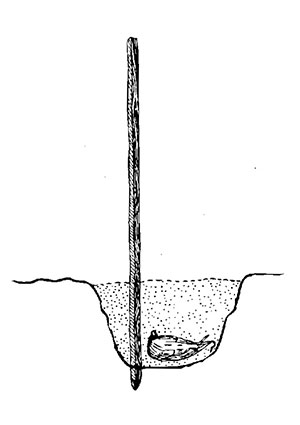
Planting Dahlias
SUMMER CARE
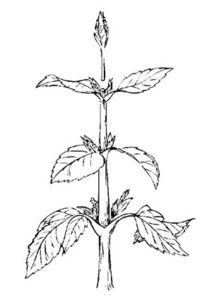
Stopping (remove growing tip)
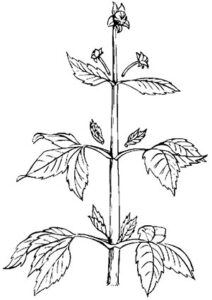
Disbudding (remove side buds)
WATERING
STOPPING
DISBUDDING
PEST CONTROL
WEEDING

CUTTING THE FLOWERS
The more you cut, the more they’ll bloom. It is best to cut dahlias early in the morning. To properly condition the blooms, place them in water in a cool, dark place away from drafts for six hours or so. Display your dahlias in a cool part of your home. By changing the water every other day, your blooms should last up to a week.
DIGGING AND STORING
After the first frost (around November 1), cut dahlias down, leaving only a short stalk. Carefully lift the tuber clump by digging at least a foot from the stalk, then slowly pull on this ‘handle’ while using the spade as a lever. Take care to shake or sweep away any loose soil to prevent broken necks; such tubers are not viable. Wash the dirt off the clump. Trim off thread-like root hairs and any damaged tubers. Don’t forget to mark or label the tubers for easy identification.
It is best to divide tuber clumps in fall shortly after digging. Use a sharp, sturdy knife or pruners. Each tuber must have a ‘growth eye’ (found where tubers attach to the main stalk). You may soak the divided tubers in 5% bleach for 15 minutes; allow them to dry well before storage.
The tubers will keep best if the storage area is cool, but always kept from freezing. An attached garage or a crawl space works well — ideally with temperatures that remain below 450 F. Fungus diseases appear where storage conditions are too warm and if there is too much moisture present. Most growers store tubers in plastic bags half filled with cedar shavings. Store bags in sturdy boxes or Styrofoam containers, such as those used for shipping grapes. Line a box with plastic or newspaper and store the bags securely until March. Check the roots twice during the winter and discard any that show rot.
Dahlia tubers left in the ground may survive cold winter days if kept from freezing. After cutting off stalks, heap mulch over the roots and cover the pile with a tarp. Good drainage is essential for tubers to be kept in this manner. However, the risk remains that a cool spring will cause them to rot. If you do not plan on digging tubers annually, plan on having a work party — after two or three years the tuber clumps can be quite large. Successful division of such clumps can present a challenge.
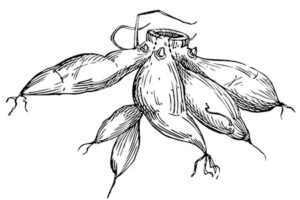
Dividing the clump. Notice the growth eyes. Each division tuber and an “eye.”
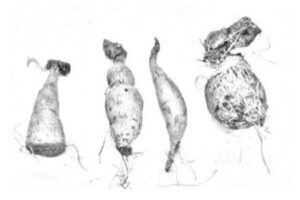
Tubers come in a range of sizes and shapes, from pencil-thin to large and plump. Plant them and they will grow.
QUESTIONS?
The Puget Sound Dahlia Association is composed of enthusiastic growers who are eager to assist you and provide more information about the growing and showing of dahlias. Our annual show in August is the largest in North America. Visit our website if you want to join, have any questions, or want to know about the club’s schedule. You can also follow us on Instagram and Facebook.


